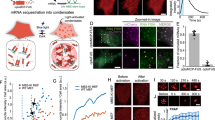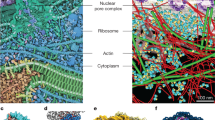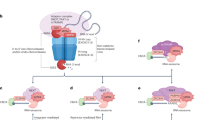Abstract
The binding of eukaryotic translation elongation factor 1A (eEF1A) to actin is a noncanonical function that may link two distinct cellular processes, cytoskeleton organization and gene expression. Using the yeast Saccharomyces cerevisiae, we have established an in vivo assay that directly identifies specific regions and residues of eEF1A responsible for actin interactions and bundling. Using a unique genetic screen, we isolated a series of eEF1A mutants with reduced actin bundling activity. These mutations alter actin cytoskeleton organization but not translation, indicating that these are separate functions of eEF1A. This demonstrates for the first time a direct consequence of eEF1A on cytoskeletal organization in vivo and the physiological significance of this interaction.
This is a preview of subscription content, access via your institution
Access options
Subscribe to this journal
Receive 12 print issues and online access
$189.00 per year
only $15.75 per issue
Buy this article
- Purchase on Springer Link
- Instant access to full article PDF
Prices may be subject to local taxes which are calculated during checkout






Similar content being viewed by others
Accession codes
References
Ong, L.L., Er, C.P., Ho, A., Aung, M.T. & Yu, H. Kinectin anchors the translation elongation factor-1δ to the endoplasmic reticulum. J. Biol. Chem. 278, 32115–32123 (2003).
Furukawa, R. et al. Elongation factor 1β is an actin-binding protein. Biochim. Biophys. Acta 1527, 130–140 (2001).
Ko, Y.G., Kang, Y.S., Kim, E.K., Park, S.G. & Kim, S. Nucleolar localization of human methionyl-tRNA synthetase and its role in ribosomal RNA synthesis. J. Cell Biol. 149, 567–574 (2000).
Chuang, S.M. et al. Proteasome-mediated degradation of cotranslationally damaged proteins involves translation elongation factor 1A. Mol. Cell. Biol. 25, 403–413 (2005).
Chen, E., Proestou, G., Bourbeau, D. & Wang, E. Rapid up-regulation of peptide elongation factor EF-1α protein levels is an immediate early event during oxidative stress-induced apoptosis. Exp. Cell Res. 259, 140–148 (2000).
Stapulionis, R., Kolli, S. & Deutscher, M.P. Efficient mammalian protein synthesis requires an intact F-actin system. J. Biol. Chem. 272, 24980–24986 (1997).
Dang, C.V., Yang, D.C. & Pollard, T.D. Association of methionyl-tRNA synthetase with detergent-insoluble components of the rough endoplasmic reticulum. J. Cell Biol. 96, 1138–1147 (1983).
Mirande, M. et al. Association of an aminoacyl-tRNA synthetase complex and of phenylalanyl-tRNA synthetase with the cytoskeletal framework fraction from mammalian cells. Exp. Cell Res. 156, 91–102 (1985).
Howe, J.G. & Hershey, J.W. Translational initiation factor and ribosome association with the cytoskeletal framework fraction from HeLa cells. Cell 37, 85–93 (1984).
Bektas, M., Nurten, R., Gurel, Z., Sayers, Z. & Bermek, E. Interactions of eukaryotic elongation factor 2 with actin: a possible link between protein synthetic machinery and cytoskeleton. FEBS Lett. 356, 89–93 (1994).
Edmonds, B.T. et al. Elongation factor-1α is an overexpressed actin binding protein in metastatic rat mammary adenocarcinoma. J. Cell Sci. 109, 2705–2714 (1996).
Yang, F., Demma, M., Warren, V., Dharmawardhane, S. & Condeelis, J. Identification of an actin-binding protein from Dictyostelium as elongation factor 1a. Nature 347, 494–496 (1990).
Munshi, R. et al. Overexpression of translation elongation factor 1α affects the organization and function of the actin cytoskeleton in yeast. Genetics 157, 1425–1436 (2001).
Liu, G. et al. Interactions of elongation factor 1α with F-actin and β-actin mRNA: implications for anchoring mRNA in cell protrusions. Mol. Biol. Cell 13, 579–592 (2002).
Carvalho, M.D., Carvalho, J.F. & Merrick, W.C. Biological characterization of various forms of elongation factor 1 from rabbit reticulocytes. Arch. Biochem. Biophys. 234, 603–611 (1984).
Edmonds, B.T., Murray, J. & Condeelis, J. pH regulation of the F-actin binding properties of Dictyostelium elongation factor 1a. J. Biol. Chem. 270, 15222–15230 (1995).
Owen, C.H., DeRosier, D.J. & Condeelis, J. Actin crosslinking protein EF-1a of Dictyostelium discoideum has a unique bonding rule that allows square-packed bundles. J. Struct. Biol. 109, 248–254 (1992).
Murray, J.W., Edmonds, B.T., Liu, G. & Condeelis, J. Bundling of actin filaments by elongation factor 1a inhibits polymerization at filament ends. J. Cell Biol. 135, 1309–1321 (1996).
Durso, N.A. & Cyr, R.J. A calmodulin-sensitive interaction between microtubules and a higher plant homolog of elongation factor-1α. Plant Cell 6, 893–905 (1994).
Kuriyama, R., Savereide, P., Lefebuve, P. & Dasgupta, S. The predicted amino acid sequence of a centrosphere protein in dividing sea urchin eggs is similar to elongation factor (EF-1a). J. Cell Sci. 95, 231–236 (1990).
Liu, G. et al. F-actin sequesters elongation factor 1a from interaction with aminoacyl-tRNA in a pH-dependent reaction. J. Cell Biol. 135, 953–963 (1996).
Andersen, G.R. & Nyborg, J. Structural studies of eukaryotic elongation factors. Cold Spring Harb. Symp. Quant. Biol. 66, 425–437 (2001).
Anand, M., Chakraburtty, K., Marton, M.J., Hinnebusch, A.G. & Kinzy, T.G. Functional interactions between yeast translation elongation factors eEF1A and eEF3. J. Biol. Chem. 278, 6985–6991 (2003).
Edmonds, B.T., Bell, A., Wyckoff, J., Condeelis, J. & Leyh, T.S. The effect of F-actin on the binding and hydrolysis of guanine nucleotide by Dictyostelium elongation factor 1A. J. Biol. Chem. 273, 10288–10295 (1998).
Kandl, K.A. et al. Identification of a role for actin in translational fidelity in yeast. Mol. Genet. Genomics 268, 10–18 (2002).
Drees, B., Brown, C., Barrell, B.G. & Bretscher, A. Tropomyosin is essential in yeast, yet the TPM1 and TPM2 products perform distinct functions. J. Cell Biol. 128, 383–392 (1995).
Evangelista, M., Pruyne, D., Amberg, D.C., Boone, C. & Bretscher, A. Formins direct Arp2/3-independent actin filament assembly to polarize cell growth in yeast. Nat. Cell Biol. 4, 32–41 (2002).
Hermann, G.J., King, E.J. & Shaw, J.M. The yeast gene, MDM20, is necessary for mitochondrial inheritance and organization of the actin cytoskeleton. J. Cell Biol. 137, 141–153 (1997).
Ito, H., Fukuda, Y., Murata, K. & Kimura, A. Transformation of intact yeast cells treated with alkali cations. J. Bacteriol. 153, 163–168 (1983).
Sikorski, R.S. & Hieter, P. A system of shuttle vectors and yeast host strains designed for efficient manipulation of DNA in Saccharomyces cerevisiae. Genetics 122, 19–27 (1989).
Towbin, H., Staehelin, T. & Gordon, J. Electrophoretic transfer of proteins from polyacrylamide gels to nitrocellulose sheets: procedure and some applications. Proc. Natl. Acad. Sci. USA 76, 4350–4354 (1979).
Honts, J.E., Sandrock, T.S., Brower, S.M., O'Dell, J.L. & Adams, A.E.M. Actin mutations that show suppression with fimbrin mutations identify a likely fimbrin-binding site on actin. J. Cell Biol. 126, 413–422 (1994).
Cavallius, J., Popkie, A.P. & Merrick, W.C. Site-directed mutants of post-translationally modified sites of yeast eEF1A using a shuttle vector containing a chromogenic switch. Biochem. Biophys. Acta 1350, 345–358 (1997).
Baim, S.B., Pietras, D.F., Eustice, D.C. & Sherman, F. A mutation allowing an mRNA secondary structure diminishes translation of Saccharomyces cerevisiae iso-1-cytochrome C. Mol. Cell. Biol. 5, 1839–1846 (1985).
Acknowledgements
The authors acknowledge the assistance of the Cancer Institute of New Jersey/Environmental and Occupational Health Sciences Institute Analytical Cytometry Image Analysis, the Robert Wood Johnson Medical School (RWJMS) DNA Core Facility sequencing laboratory and the fluorescence microscopy laboratory in the RWJMS Department of Pharmacology. This research was supported by a grant from the US National Institutes of Health (GM62789 to T.G.K.).
Author information
Authors and Affiliations
Corresponding author
Ethics declarations
Competing interests
The authors declare no competing financial interests.
Supplementary information
Supplementary Fig. 1
N305S and N329S eEF1A/Ura3p mutant do not show polyribosomes accumulation. (PDF 1118 kb)
Supplementary Table 1
S. cerevisiae strains used in this study. (PDF 97 kb)
Rights and permissions
About this article
Cite this article
Gross, S., Kinzy, T. Translation elongation factor 1A is essential for regulation of the actin cytoskeleton and cell morphology. Nat Struct Mol Biol 12, 772–778 (2005). https://doi.org/10.1038/nsmb979
Received:
Accepted:
Published:
Issue Date:
DOI: https://doi.org/10.1038/nsmb979
This article is cited by
-
Immune cell infiltration and drug response in glioblastoma multiforme: insights from oxidative stress-related genes
Cancer Cell International (2024)
-
Multidimensional insights into the repeated electromagnetic field stimulation and biosystems interaction in aging and age-related diseases
Journal of Biomedical Science (2022)
-
Overexpressing eukaryotic elongation factor 1 alpha (eEF1A) proteins to promote corticospinal axon repair after injury
Cell Death Discovery (2022)
-
Development of an efficient Tef-1α RNA hairpin structure to efficient management of Lasiodiplodia theobromae and Neofusicoccum parvum
Scientific Reports (2021)
-
Comparative proteomic profiling of newly acquired, virulent and attenuated Neoparamoeba perurans proteins associated with amoebic gill disease
Scientific Reports (2021)



